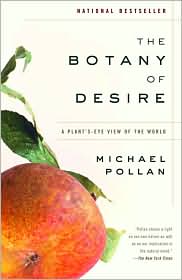What a great book! There is so much fascinating information in here. The book highlights the co-evolution of four different plant with humans and the particular element for which they are selected… apple/sweetness, tulip/desire, cannabis/intoxication, and potato/control. Here is an excerpt from the chapter on the tulip/desire:
Once upon a time, there were no flowers – two hundred million years ago, to be only slightly more precise. There wer plants then, of course, ferns and mosses, conifers and cycads, but these plants didn’t form true flowers or fruit. Some of them reproduced asexually, cloning themselves by various means. Sexual reproduction was a relatively discreet affair usually accomplished by releasing pollen onto the wind or water; sheer chance some of it would find its way to other members of the species, and a tiny, primitive seed would result. This preloriferous world was a slower, simpler, sleepier world than our own. Evolution proceeded more slowly, there being so much less sex, and what sex there was took place among closepby and closely related plants. such a conservative approach to reproduction made for a biologically simpler world, since it generated relatively little nobelty or variation. Life on the whole was more local and inbred.
The world before flowers was sleepier than ours because, lacking fruit and large seeds, it couldn’t support many warm blooded creatures. Reptiles ruled, and life slowed to a crawl whenever it got cold; little happened at night. It was a plainer-looking world, too, greener even than it is now, absent all the colors and patterns (not to mention scents) that flowers and fruits would bring into it. Beauty did not yet exist. That is, the way things looked had nothing to do with desire.
Flowers changed everything. The angiosperms, as botanists call the plants that form flowers and then encased seeds, appeared during the Cretaceous period, and they spread over the earth with stunning rapidity. “An abominable mystery” is how Charles Darwin described this sudden and entirely evitable event. Now, instead of relying on wind or water to move genes around, a plant could enlist the help of and animal by striking a grand co-evolutionary compact: nutrition in exchange for trasnportation. With the advent of the flower, whole new levels of complexity come into the world: more interdependence, more information, more communication, more experimentation.
The evolution of plants proceeded according to a new motive force: attraction between different species. Now natural selection favored blooms that could rivet the attention of pollinators, fruits that appealed to foragers. the desires of other creatures became paramount in the evolution of plants, for the simple reason that the plants that succeeded at gratifying those desires would up with more offspring. Beauty had emerged as a survival strategy.
The new rules speeded the rate of evolutionary change. Bigger, brighter, sweeter, more fragrant: all these qualities were quickly rewarded under the new regime. But so was specialization. since bestowing one’s pollen on an insect that might deliver it to the wrong address (such as the blossoms of unrelated species) was wasteful, it becme an advatage to look and smell as distinctive as possible, the better to command the undivided attention of a single dedicated pollinator. Animal desire was thus parsed and subdivided, plants specialized accordingly, and an extraordinary flowering of diversity took place, much of it under the signs of co-evolution and beauty.
With flowers came fruit and seeds, and these, too remade life on Earth. By producing sugars and proteins to entice animals to disperse their seed, the angiosperms multiplied the world’s supply of food energy, making possible the rise of large warm-blooded mammals. Without flowers, the reptiles, which had gotten along fine in a leafy, fruitless world, would probably still rule. Without flowers, we would not be.
-- Weather When Posted --
- Temperature: 98°F;
- Humidity: 31%;
- Heat Index: 99°F;
- Wind Chill: 98°F;
- Pressure: 30.09 in.;


